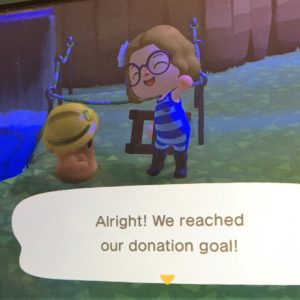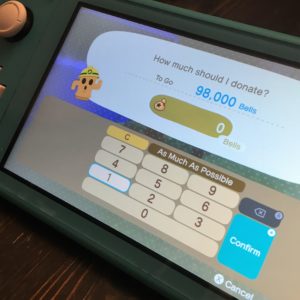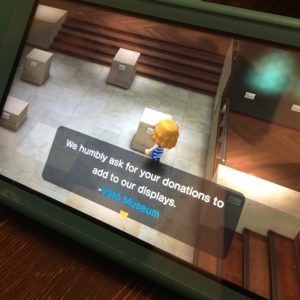 The holiday gift-giving season is here, and video games have made the wish lists of many. Nintendo has been having a great year, driven in large part by the popularity of the game “Animal Crossing: New Horizons” or ACNH. Sales of the game, released in March, have topped 26 million copies, and the game has also helped drive sales of the hardware required to play it, the Nintendo Switch. The game allows players to create their own islands which are inhabited by villagers from different animal species and open for visits from other game players. Almost everything can be customized by the island’s owner, and it’s all pretty darn cute. But what caught my attention about this game is that one of the ways you can shape your virtual world is through your own in-game philanthropy!
The holiday gift-giving season is here, and video games have made the wish lists of many. Nintendo has been having a great year, driven in large part by the popularity of the game “Animal Crossing: New Horizons” or ACNH. Sales of the game, released in March, have topped 26 million copies, and the game has also helped drive sales of the hardware required to play it, the Nintendo Switch. The game allows players to create their own islands which are inhabited by villagers from different animal species and open for visits from other game players. Almost everything can be customized by the island’s owner, and it’s all pretty darn cute. But what caught my attention about this game is that one of the ways you can shape your virtual world is through your own in-game philanthropy!
This internationally popular game has its own currency, “Bells,” which players can earn by collecting and selling various items or by investing in turnips through the “stalk market.” They can spend their Bells on themselves—buying clothes for their avatars, furnishing and landscaping their virtual homes, or customizing their islands. But this social game also encourages players to share their riches with others, either by giving presents to the island’s villagers and other game players or by making gifts to benefit the island’s community.
One of the challenges on these virtual islands can be moving through the terraformed geography. In order to make all areas of the island easily accessible, community fundraising campaigns are held to build bridges and inclines. A hard-hat-wearing character named Lloid does an okay job as solicitor. On the plus side, he clearly states what the project is and its fundraising goal and asks for a gift, although not for a specific amount. But he may be lowering sights when he suggests that even a single Bell will help. When the prospective donor would be the first to support the capital project, the variable data causes Lloid to make an unnecessarily snide remark—“Currently we have 0 Bells in donations, which is just lovely, isn’t it?”
 When a player decides to donate, she is presented with an online giving page that includes a giving amount option that is absent from all of our real-life sites—“As Much As Possible.” The “Bells” still needed to achieve the fundraising goal appear at the top, decreasing in real time based on what the player enters as a gift amount.
When a player decides to donate, she is presented with an online giving page that includes a giving amount option that is absent from all of our real-life sites—“As Much As Possible.” The “Bells” still needed to achieve the fundraising goal appear at the top, decreasing in real time based on what the player enters as a gift amount.
Lloid makes sure to thank the donor immediately, and, if the player’s gift gets the project to goal, Lloid and the donor briefly celebrate. (You can see that in the image at the start of this post.) While this is terrific on its own, it will be followed up with additional stewardship later.
 There is also a museum complex on each island that relies on donations for its displays. Players can choose to give artwork, fossils, aquatic life, and bugs they collect to the museum, making them available for everyone who visits to enjoy, rather than sell them to amass more Bells. When players click on a vacant spot in the museum, they see a message which encourages them to make donations. The emptiness of the space strongly illustrates the need.
There is also a museum complex on each island that relies on donations for its displays. Players can choose to give artwork, fossils, aquatic life, and bugs they collect to the museum, making them available for everyone who visits to enjoy, rather than sell them to amass more Bells. When players click on a vacant spot in the museum, they see a message which encourages them to make donations. The emptiness of the space strongly illustrates the need.
The museum’s director, an owl named Blathers, accepts players’ gifts of virtual tangible personal property, thanks them, and reassures them that their gifts will be displayed in the galleries in a timely manner.
Mirroring real-world stewardship practices, when the items go on display in ACNH museums, donors’ names are included on the museum’s plaques. Here are plaques for a few of the items donated by my daughters to the museum on their island:
Let’s go back to those gifts made for capital improvements. Once again, the game takes a cue from real-world stewardship practices and holds dedication ceremonies to which all villagers are invited. Players who make the donations are invited to “speak,” with three comments from which they can choose, two of which emphasize community: “Good for us!”, “We’re amazing!”, and “Woohoo!”. The ceremony includes lots of applause, confetti, and a group photo op.

Last month, researchers at the Oxford Internet Institute at the University of Oxford announced surprising results of a new study on video game playing and well-being which looked at two games, Animal Crossing: New Horizons and Plants vs. Zombies: Battle for Neighborville. They found that individuals who played ACNH for four hours per day reported higher levels of well-being than non-players. Professor Andrew Przybylski, the lead author of the study, speculated that the social aspects of the game, which allow you to interact with your real-world friends in a new way, could explain the increase in well-being. But as a fundraiser and donor, I believe that the opportunities the game provides to make an impact on your community and be recognized for your generosity are also part of the explanation. Giving often leaves the donor feeling a “warm glow.” The authors suggest that future research should examine specific behaviors and activities within the game. I hope that they’ll be able to report back on the mental health impact of giving to others while at play. I also hope that the over 26 million people around the world playing Animal Crossing: New Horizons, who are likely feeling good about their philanthropy in the virtual world, will choose to feel even better by giving to support their real-world communities. After all, philanthropy is a game where everybody wins!
Tammie L. Ruda

